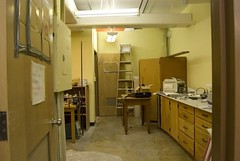

Here is the rabbit-warren to be renovated in Weniger Hall…and the cutting-edge classroom that will be created to carry out the “Paradigms In Physics” program for first-and second-year students in Physics at OSU.
The experience of being an upper-level undergraduate student in Physics at OSU has been transformed through a re-envisioning of the learning process. Our program, “Paradigms in Physics”, is funded by the National Science Foundation and is the first curriculum of its type in the country.
For example, they can start directly from physical observations and experimentation with equipment, move to problem solving for that situation, and then explore more difficult extensions through computer simulations. Students can work at a more flexible pace, and use interactions with each other and the instructors as ways to test and explore their own understanding. In dedicated, modernized classrooms with high-tech teaching aids, students will sit at modular tables with three students to a group. Students can face forward when information needs to be delivered to the class as a whole, but a quick move of chairs will transform the class into working groups. Each group will have a tablet PC for problem-solving, access to small equipment modules for testing ideas, and a white-board and a smart-board for brainstorming. Information will be uploaded to the instructor’s computer for real-time feedback on problem-solving. The group members will discuss amongst themselves, create models, physically test predictions based on their models, and present solutions to the entire class.
This active learning style has been proven to change thought patterns, excite strong students, and provide support for weaker students.
—-
We’re working on funding the $500,000 budget for this project via private support–we’re about $200k toward that goal so far.


